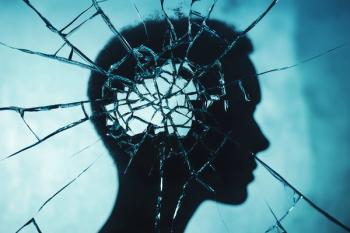
Insomnia and the Antisuicidal Properties of Clozapine
Sleep and suicide? Researchers investigated improvement in insomnia as a pathway underlying the antisuicidal properties of clozapine.
CASE VIGNETTE
“Mrs Lestrange” is a 40 year-old Caucasian woman with a history of chronic schizoaffective disorder, bipolar type. The onset of her psychosis was at age 30. In response to multiple recent stressors—including financial, transportation, and medical work-up for possible cancer—she experienced worsening insomnia and paranoia. Subsequently, she overdosed on multiple, unspecified medications at home in a suicide attempt, and was hospitalized for a fourth time in the past 10 years. During the admission, she was started on clozapine, which was titrated to a dose of 300 mg/day, with improvement in sleep and positive symptoms.
Insomnia is common in schizophrenia, affecting one-quarter to one-half of patients.1,2 A recent meta-analysis of 10 studies found that insomnia was associated with a significant increased odds of suicidal ideation and suicide attempt or death.3 These findings are particularly relevant, given a 27% lifetime prevalence of suicide attempt4 and a 5% lifetime prevalence of suicide death in schizophrenia.5
Clozapine is the only antipsychotic with an indication for suicide prevention in schizophrenia from the US Food and Drug Administration (FDA).6 Sedation is a common adverse effect of treatment with clozapine. In a meta-analysis of 8 randomized controlled trials, patients treated with other antipsychotics vs clozapine had a significant increased odds of insomnia.7 Utilizing data from the FDA Adverse Event Reporting System for which a second-generation antipsychotic (SGA) was the suspected agent of a psychiatric adverse drug reaction, we found that compared with clozapine, all other SGAs were associated with a significantly increased reported odds of both insomnia and suicidal ideation and behavior. Furthermore, the reporting odds ratios for insomnia and suicidal ideation and behavior were positively correlated.
The mechanism(s) by which clozapine is associated with decreased suicide are likely complex and multifactorial, and the associated literature in this area is quite modest. However, our data raise the (relatively straightforward) possibility that improvements in insomnia directly contribute to decreased suicidal ideation and behavior with clozapine.
The Current Study
Vayalapalli et al aimed to investigate whether effects on insomnia are associated with the antisuicidal properties of clozapine, using a well-characterized sample of patients with schizophrenia.8 Publicly available data were obtained from the CATIE schizophrenia trial.9 Briefly, in phase 1 of the CATIE trial, 1460 patients with schizophrenia were randomized to 1 of 5 different antipsychotics for up to 18 months. Phase 2 of the CATIE trial included 49 patients who discontinued treatment in phase 1 due to lack of efficacy and were randomized to open-label treatment with clozapine.10 Phase 3 of the CATIE trial included another 37 patients who discontinued treatment in phase 1 and 2 and selected open-label treatment with clozapine.11
In the present study, using a within-subjects design, we investigated relationships between terminal insomnia (early awakening) and suicidal ideation (over the past 2 weeks): (1) after treatment with nonclozapine antipsychotics (phase 1 or 2), and then (2) after treatment with clozapine (phase 2 or 3). Terminal insomnia and suicidal ideation over the past 2 weeks was assessed using the Calgary Depression Scale for Schizophrenia (CDSS).
We investigated the association between terminal insomnia and suicidal ideation using logistic regression models. Age, sex, race, smoking, BMI, alcohol and drug use, depression (CDSS total score minus the terminal insomnia and suicide items), and psychosis (PANSS total score minus depression item) were included in the models. Separate logistic regression models were used to investigate: terminal insomnia and suicidal ideation before and after treatment (nonclozapine and clozapine), and resolution of terminal insomnia and resolution of suicidal ideation after treatment (nonclozapine and clozapine).
We included n=76 subjects from the CATIE trial with data on terminal insomnia and suicidal ideation before and after treatment with nonclozapine and clozapine antipsychotics. Mean subject age was 38, 86% were male, and 75% were Black. The mean modal clozapine dose was 333 mg (± 166 mg). The mean length of time between the last visit on a nonclozapine antipsychotic and the first visit on clozapine was 29 ± 14 days.
At the phase 1 or 2 visit before starting a nonclozapine antipsychotic, the prevalence of terminal insomnia was 24% and the prevalence of suicidal ideation was 22%. In a logistic regression model, terminal insomnia before nonclozapine antipsychotic treatment was not associated with concurrent suicidal ideation (OR=0.6, 95% CI 0.2-15.7, P=0.74).
At the final phase 1 or 2 visit after treatment with a nonclozapine antipsychotic, the prevalence of terminal insomnia increased to 33% and the prevalence of suicidal ideation was essentially unchanged at 24%. In a logistic regression model, terminal insomnia after nonclozapine treatment was not associated with concurrent suicidal ideation (OR=0.2, 95% CI 0.0-3.3, P=0.37). Only 1 patient had concurrent resolution of both terminal insomnia and suicidal ideation with a nonclozapine antipsychotic.
At the visit before starting clozapine, the prevalence of terminal insomnia was 30% and the prevalence of suicidal ideation was 21%. In a logistic regression model, terminal insomnia before clozapine treatment was associated with significant, almost 5-fold increased odds of concurrent suicidal ideation (OR=4.9, 95% CI 1.0-23.5, P<0.05).
At the final visit after treatment with clozapine, the prevalence of terminal insomnia decreased to 11% and the prevalence of suicidal ideation decreased to 8%. In a logistic regression model, terminal insomnia after clozapine treatment was no longer associated with concurrent suicidal ideation (OR=1.3, 95% CI 0.0-52.3, P=0.90). Among the 23 subjects with terminal insomnia before starting clozapine, after treatment with clozapine the prevalence of insomnia decreased to 17% and the prevalence of suicidal ideation decreased from 35% to 9%.
ln a logistic regression model, after controlling for age, sex, race, smoking, alcohol and drug use, BMI, the change in PANSS total score (minus the depression item), and the change in CDSS score (minus the terminal insomnia and suicidal ideation items), resolution of terminal insomnia was associated with an over 14-fold increased odds of resolution of suicidal ideation after treatment with clozapine (OR=14.6, 95% CI 1.7-129.6, P=0.02). Among the 8 patients with both terminal insomnia and suicidal ideation before treatment clozapine, the prevalence of terminal insomnia was 0% and the prevalence of suicidal ideation was 12.5% after clozapine.
Study Conclusions
In the present study, we found resolution of terminal insomnia was associated with an over 14-fold increased odds of resolution of suicidal ideation after treatment with clozapine, after controlling for multiple potential confounding factors, including changes in depressive symptoms and other psychopathology. By contrast, in the same patients, resolution of terminal insomnia was not associated with resolution of suicidal ideation after treatment with a nonclozapine antipsychotic.
A notable strength is that this is the first study to show that improved insomnia is associated with improved suicidal ideation in patients treated with clozapine. We were able to show that this association was specific to clozapine, as it was not found during a period of nonclozapine antipsychotic treatment for the same patients. The use of this within-subjects design may also minimize potential residual confounding. Another strength of the present study includes the consideration of multiple potential confounding factors, notably depressive symptoms.
Study limitations include the self-reported measures of insomnia and suicide, which were dichotomized as yes/no variables because of small numbers of subjects with moderate and severe ratings. Another limitation was that the assessment of insomnia was limited to terminal insomnia. There was also inadequate data to analyze associations between insomnia and suicide attempts during treatment. Another limitation was the variable clinical status of subjects (inpatient and outpatients).
The Bottom Line
The present study provides evidence that improved insomnia is one pathway underlying the antisuicidal properties of clozapine. Findings warrant replication in a larger sample with standard instruments in the assessment of both insomnia and suicide. Future mechanistic studies are also needed. Given associations with suicide, the present findings also suggest more broadly that insomnia may represent an important treatment target in schizophrenia.
Dr Miller is professor in the Department of Psychiatry and Health Behavior, Augusta University, Augusta, Georgia. He is on the Editorial Board and serves as the schizophrenia section chief for Psychiatric Times. The author reports that he has received research support from Augusta University, the National Institute of Mental Health, and the Stanley Medical Research Institute.
References
1. Batalla-Martín D, Belzunegui-Eraso A, Miralles Garijo E, et al.
2. Hou CL, Li Y, Cai MY, et al.
3. Miller BJ, McCall WV.
4. Lu L, Dong M, Zhang L, et al.
5. Hor K, Taylor MJ.
6. Kasckow J, Felmet K, Zisook S.
7. Miller BJ, McEvoy JP, McCall WV.
8. Vayalapalli A, McCall WV, McEvoy JP, Miller BJ.
9. Lieberman JA, Stroup TS, McEvoy JP, et al.
10. McEvoy JP, Lieberman JA, Stroup TS, et al; CATIE Investigators.
11. Stroup TS, Lieberman JA, McEvoy JP, et al; CATIE Investigators.
Newsletter
Receive trusted psychiatric news, expert analysis, and clinical insights — subscribe today to support your practice and your patients.













